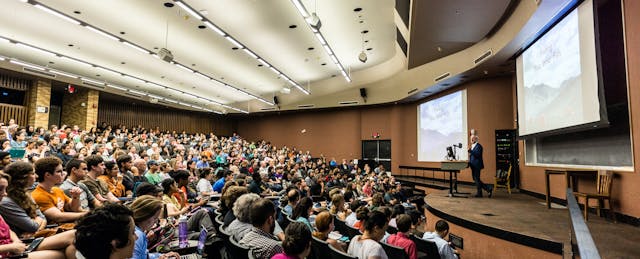Some introductory courses have a “weed-out” reputation for narrowing the paths students can take through college. (Organic chemistry, anyone?)
Research by the nonprofit Gardner Institute and other groups has found that these typically-freshman-year classes tend to prune some kinds of students from academic tracks more than others. For example, a new study published in the journal PNAS Nexus found that, among students who perform poorly in intro STEM classes, those who are underrepresented minorities are even less likely to end up earning STEM degrees than their white, male counterparts.
And the pandemic may be exacerbating this situation. Research out this year from consulting firm Tyton Partners, the Bill & Melinda Gates Foundation and Every Learner Everywhere found that professors lately are reporting an increase in the DFWI rate—that is, the percent of students in a course who receive a D grade, fail, withdraw or don’t complete the class.
“Statistics show significant inequities in the completion rate in gateway courses,” says Andrea Jones-Davis of Educause. “Research shows students may drop out or change their major based on these gateway courses.”
Jones-Davis is the director of a new effort, CourseGateway, which aims to help more students—and especially Black, Latino, indigenous and low-income students—succeed in the first few classes they encounter in higher ed by promoting the adoption of high-quality courseware, a category of tech tools that packages digital reading materials with assessments and study supports. The theory is that courseware has the potential to improve student outcomes because it tends to offer students personalized instruction and instant feedback on their work, Jones-Davis says. These tools can also help instructors track whether and how students are studying and completing assignments.
CourseGateway reviews existing courseware products according to five criteria: equity, efficacy, functionality, systems capacities and privacy, data protection and rights. The platform launched in June with reviews of 16 products, including tools made by OpenStax, Wiley, Lumen Learning, Pearson and Labster. Each review also notes the starting price per student per semester; some are free or cost as little as $1 per student, while others cost between $60 and $100.
The platform doesn’t make ratings or recommendations, but it does aim to provide enough information so that higher ed educators can select products for use in courses. About 37 percent of faculty teaching introductory courses said that they used courseware in 2022, according to the Tyton Partners study of 850 administrators and 3,200 faculty at 1,200 colleges.
The product reviews are conducted by an advisory board made up of university professors, administrators and innovation experts (the board is soliciting new members through Oct. 30). Reviews take into account some information provided by courseware makers, but Jones-Davis says suppliers don’t have input into the design of the review rubric. She hopes that the transparent review process can influence edtech companies to prioritize strong outcomes for all students.
“Our goal is to nudge suppliers to use the platform as well, to see how their ratings are,” Jones-Davis says, so that “they can understand how to build more equitable courseware.”
The project, funded from the Bill & Melinda Gates Foundation and housed at Educause, prioritizes 20 key gateway courses, including introductory classes in biology, chemistry, English, economics and psychology, as well as math classes like algebra and calculus, and U.S. history surveys.
Leaders of the project aim to evaluate products twice a year and then update the site accordingly.


